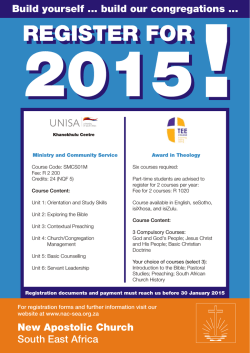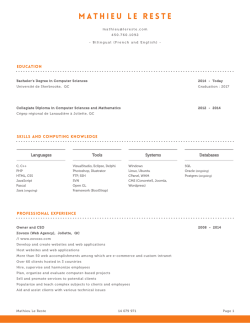
General Education courses taught by NELC faculty
Culture and Belief 19. Understanding Islam and Contemporary Muslim Societies Catalog Number: 1065 Ali S. Asani (Study of Religion; Near Eastern Languages and Civilizations) Half course (spring term). Tu., 7:40-9:40 p.m., and a weekly section to be arranged. EXAM GROUP: 6 The course is an introduction to the fundamental concepts of Islam and the role that religious ideas and institutions play in Muslim communities around the world. Its main concern is to develop an understanding of the manner in which diverse notions of religious and political authority have influenced Muslim societies politically, socially and culturally. Through specific case studies of countries such as Saudi Arabia, Iran, Turkey, Egypt, Pakistan, and Afghanistan, the course considers the role played by ideologies such as jihad, colonialism, nationalism, secularism, and globalization in shaping the ways in which Muslims interpret and practice their faith today. The course briefly considers the contemporary situation of Muslim minorities in Europe and the United States. The course, through on-campus and online options, allows those enrolled to engage with students from all over the world. Note: Expected to be omitted in 2015–16. Offered jointly with the Divinity School as 3628. This course fulfills the requirement that one of the eight General Education courses also engage substantially with Study of the Past. Culture and Belief 23. From the Hebrew Bible to Judaism, From the Old Testament to Christianity Catalog Number: 5275 Shaye J.D. Cohen (Near Eastern Languages and Civilizations) Half course (spring term). M., W., (F.), at 10, and a weekly section to be arranged. EXAM GROUP: 5 The Hebrew Scriptures, what Christians call the “Old Testament” and Jews call the “Bible,” are the basis of both Judaism and Christianity. In this course we shall survey how this work of literature, through interpretation and re-interpretation, spawned two different cultural systems. Topics to be surveyed include: canon and prophecy; exegesis and Midrash; Shabbat and Sunday; temple, synagogue, church; the Oral Torah and the Logos; sin and righteousness; messiah and redemption. Note: This course fulfills the requirement that one of the eight General Education courses also engage substantially with Study of the Past. Culture and Belief 27. Among the Nations: Jewish History in Pagan, Christian and Muslim Context Catalog Number: 2338 Jay M. Harris (Near Eastern Languages and Civilizations) Half course (spring term). M., W., F., at 11, and a weekly section to be arranged. . EXAM GROUP: 14 Can we trace an “authentic” Jewish identity through history, as distinct from many “cultures” of Jews in the multitude of times and places in which they have lived? This course provides an overview of major trends in Jewish civilization from biblical times through the early modern era (to approximately the 17th century), with this and related questions in mind, by engaging in close readings of traditional Jewish sources on the one hand and seeking contextual understandings of Jews and Judaism within various non-Jewish settings on the other. Note: Required of all secondary concentrators in Jewish Studies, unless excused by the DUS. This course fulfills the requirement that one of the eight General Education courses also engage substantially with Study of the Past. Culture and Belief 39. The Hebrew Bible Catalog Number: 9783 Shaye J.D. Cohen (Near Eastern Languages and Civilizations) Half course (fall term). M., W., (F.), at 10, and a weekly section to be arranged. EXAM GROUP: 5 This course is a survey of the major books and ideas of the Hebrew Bible (commonly called the Old Testament). The course will also treat the historical contexts in which the Bible emerged, and the Bible’s role as canonical scripture in Judaism and Christianity. Note: All readings in translation. No prior knowledge of the subject is assumed. This course fulfills the requirement that one of the eight General Education courses also engage substantially with Study of the Past. Culture and Belief 48. God, Justice, and the Book of Job Catalog Number: 7991 Peter Machinist (Near Eastern Languages and Civilizations) Half course (fall term). M., W., (F.), at 12, and a weekly section to be arranged. EXAM GROUP: 11 An examination of the biblical book of Job along with related texts, ancient, medieval, and modern, that allow us to establish the literary and philosophical traditions in which Job was composed and the literary and philosophical legacy it has left. Particular focus on the ways the texts play off one another in literary form and expression and in their treatment of such themes as divine justice, human piety, and the nature of the divine-human encounter. Note: Expected to be omitted in 2015–16. This course fulfills the requirement that one of the eight General Education courses also engage substantially with Study of the Past. Ethical Reasoning 15. “If There is No God, All is Permitted:” Theism and Moral Reasoning Catalog Number: 1321 Jay M. Harris (Near Eastern Languages and Civilizations) Half course (fall term). M., W., (F.), at 12, and a weekly section to be arranged. EXAM GROUP: 11 This course will examine the ways in which a concept of God has informed Western moral discourse trying to help students engage the literature as they consider why one might think “if there is no God, all is permitted” and why one might think if there is a God, human moral achievement is impossible. Ethical Reasoning 37 (formerly History of Art and Architecture 50g). Adam & Eve Catalog Number: 81501 Joseph Koerner (History of Art & Architecture) and Stephen J. Greenblatt (Near Eastern Languages and Civilizations) Half course (spring term). M., W., at 1. EXAM GROUP: 8 What is the power of a story? For several thousand years Adam and Eve were the protagonists in the central origin myth of the Jewish, Christian, and Muslim worlds. That myth was the arena for ethical reasoning about transgression and innocence, sexuality, gender roles, labor, suffering, and death. Jointly taught by History of Art and Architecture and English, our course focuses on this enigmatic story and its spectacular elaborations in theology, philosophy, literature and art. Above all, looking closely at some of the greatest achievements of European art and literature— from Dürer, Michelangelo and Rembrandt to Milton’s Paradise Lost— we will compare the possibilities of the verbal and visual arts in portraying human being. Note: This course, when taken for a letter grade, meets the General Education requirement for Ethical Reasoning or Aesthetic and Interpretive Understanding, but not both. Societies of the World 38. Pyramid Schemes: The Archaeological History of Ancient Egypt Catalog Number: 36776 Peter Der Manuelian (Near Eastern Languages and Civilizations; Anthropology) Half course (spring term). M., W., at 11, and a weekly section to be arranged. EXAM GROUP: 14 Surveys ancient Egyptian pharaonic civilization. Emphasizes Egyptian material culture: pyramids, temples, tombs, settlements, and artifacts. Explores major developmental themes that defined the Egyptian state: the geographical landscape, kingship, social stratification, and religion. Follows a chronological path with excursions into Egyptian art, history, politics, religion, literature, and language (hieroglyphs). Also touches on contemporary issues of object repatriation, archaeology and cultural nationalism, and the evolution of modern Egyptology. Includes field trips to the Egyptian collections of the Peabody Museum and the Museum of Fine Arts, Boston, along with immersive 3D computer models in Harvard’s Visualization Center. No prior experience in Egyptology expected. Note: This course fulfills the requirement that one of the eight General Education courses also engage substantially with Study of the Past. Societies of the World 54 (formerly Religion 1832). Islam and Politics in the Modern Middle East Catalog Number: 43973 Malika Zeghal Half course (spring term). M., W., at 10 and hour to be arranged. EXAM GROUP: 5 This course examines the origins, ideologies, and political strategies of twentieth and twenty-first century Islamist movements in the Middle East and beyond. We will pay particular attention to the evolution of these movements in the larger historical and political context, up to and including the Arab Spring. We will use primary sources in translation and in Arabic (for those with reading proficiency). There are no language or other prerequisites for this class. Note: Offered jointly with the Divinity School as 3361. This course fulfills the requirement that one of the eight General Education courses also engage substantially with Study of the Past. →The courses listed below are also taught by NELC faculty, but not offered 2014-15. [Aesthetic and Interpretive Understanding 54 (formerly Culture and Belief 12). For the Love of God and His Prophet: Religion, Literature, and the Arts in Muslim Cultures] Catalog Number: 7027 Ali S. Asani (Study of Religion; Near Eastern Languages and Civilizations) Half course (spring term). Tu., Th., 11:30-1, and a weekly section to be arranged. The course surveys the literary and artistic dimensions of the devotional life of the world’s Muslim communities, focusing on the role of literature and the arts (poetry, music, architecture, calligraphy, etc.) as expressions of piety and socio-political critique. An important aim of the course is to explore the relationships between religion, literature, and the arts in a variety of historical and cultural contexts in the Middle East, sub-Saharan Africa, South Asia, Europe, and America. Note: Expected to be given in 2015–16. No prior knowledge of Islam required. You do not need to be "artistically" talented to do well in this course -- just willing to think "out of the box." Offered jointly with the Divinity School as 3627. This course, when taken for a letter grade, meets the General Education requirement for Aesthetic and Interpretive Understanding or Culture and Belief, but not both. This course fulfills the requirement that one of the eight General Education courses also engage substantially with Study of the Past. [Culture and Belief 13. The Contested Bible: The Sacred-Secular Dance] Catalog Number: 9458 Jay M. Harris (Near Eastern Languages and Civilizations) Half course (spring term). M., W., F., at 10, and a weekly section to be arranged. A short history of the Bible. Questions addressed include how the Bible became a book, and how that book became sacred; the advantages and burdens of a sacred text; Jewish-Christian disputations; how interpretive efforts helped create and reinforce powerful elites; how that text became the object of criticism; and how the Bible fared after the rise of criticism. Note: This course fulfills the requirement that one of the eight General Education courses also engage substantially with Study of the Past. [Culture and Belief 32. Back Roads to Far Places: Literature of Journey and Quest] Catalog Number: 39198 William A. Graham (Near Eastern Languages and Civilizations; The Study of Religion) and Stephanie A. Paulsell (Harvard Divinity School) Half course (spring term). M., W., at 10, and a weekly section to be arranged. Explores themes of journey and quest in world literature and the interplay between their literary and religious dimensions. Considers the relationship between physical and interior journeys, home and exile, quest and peregrination. Emphasis will be on careful reading of, and thoughtful essays on, texts such as Gilgamesh, the Bible, Quest of the Holy Grail, Walden, and works by Tolkien, Dante, Teresa of Avila, Ashvaghosha, Hesse, Basho, Shusako Endo, Charles Johnson, Virginia Woolfe, and Cormac McCarthy. Note: Expected to be given in 2015–16. Offered jointly with the Divinity School as 2490. This course fulfills the requirement that one of the eight General Education courses also engage substantially with Study of the Past. [Societies of the World 35. Conditional Equality: The Case of the Jews of Europe in Modern Times] Catalog Number: 88298 Jay M. Harris (Near Eastern Languages and Civilizations) Half course (fall term). M., W., (F.), at 12, and a weekly section to be arranged. This course is a study in the relations between majorities and minorities in modern Europe, using the Jews as a focus. It will examine the ways in which the equal status of a minority is negotiated through cultural and political interaction, both subtle and blunt. It will further focus on the role that such negotiations have in the formation of identities of both the majority and the minority. Finally, it will examine the ways in which majorities can exercise control over minorities rendering them conditionally rather than fully equal participants in the national projects of the age. Note: Expected to be given in 2015–16. This course fulfills the requirement that one of the eight General Education courses also engage substantially with Study of the Past.
© Copyright 2025







